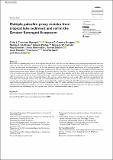| dc.description.abstract | Black carbon is a paleofire proxy that has been measured from glacial ice, snow, soils and lake sediments, though relatively few comparisons have been made with other fire indicators in sedimentary geoarchives. Microscopic charcoal, quantified from palynological microscope slides and macroscopic charcoal, quantified from wet-sieved deposits, are the most commonly applied methods for paleofire interpretation of Quaternary sediments. This research explores the down-profile patterns across three paleofire proxies (refractory black carbon, microscopic and macroscopic charcoal) and potential paleofire interpretations from a sediment core dating to the last centuries from Speke Gulf, Lake Victoria, and a young soil profile from a kopje located in the surrounding watershed in Serengeti National Park, Tanzania. The results of three paleofire metrics show similar trends within each site, with a positive trend across all metrics and increasing variability with increased measurement values (heteroscedastic). Notably, refractory black carbon (rBC) concentrations are two orders of magnitude higher in lake sediment samples compared to soil samples. rBC is positively correlated with both microscopic and macroscopic charcoal values and the overall profile patterns down the sediment core are similar, with the exception of the rBC increases from 2.5 to 0 cm depth that may result from increased fossil fuel combustion. The Speke Gulf rBC measurements are in an intermediate range between those published from glacial ice and other lake sediments. New rBC records from different ecosystems and temporal scales will provide paleofire insights and potential to interpret source areas and depositional patterns. The exploration of soil archives offers the potential to exploit semi-arid ecosystems and archaeological sites that have no nearby traditional paleoenvironmental study site targets. | en_US |

